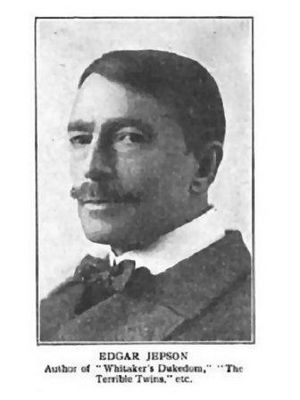Edgar Jepson facts for kids
Quick facts for kids
Alfred Jepson
|
|
|---|---|

National Magazine, 1915
|
|
| Born |
Edgar Alfred Jepson
28 November 1863 Bloomsbury, London, England
|
| Died | 12 April 1938 (aged 74) Hampstead, London, England
|
| Occupation | Author |
| Spouse(s) | Frita Bisham Holmes 1899–1933 (divorced) |
Edgar Alfred Jepson (born November 28, 1863 – died April 12, 1938) was an English writer. He was known for writing exciting adventure and detective stories. He also wrote tales about magic and fantasy. Sometimes, he used a different name, R. Edison Page, for his stories.
Growing Up
Edgar Jepson was born in Bloomsbury, London, on November 28, 1863. He grew up in a town called Kenilworth, Warwickshire. He was one of eight children. His father was a dentist. Edgar went to Leamington College for Boys. Later, he studied at Balliol College, Oxford. After finishing school, he lived in Barbados for a few years. Then, he moved back to London. This is where he started his writing career.
Becoming a Writer
As a writer, Edgar Jepson sometimes used the pen name R. Edison Page. A pen name is a fake name used by an author. He also worked with other writers on some of his books. He even translated stories from other languages. For example, he translated the famous Arsène Lupin stories. These were written by Maurice Leblanc.
Jepson was part of a group called the Square Club. This club was for well-known writers. He was also a good friend of the author Ford Madox Ford. For a short time, Jepson was the editor of Vanity Fair magazine. He helped to remember another writer, Richard Barham Middleton, after he passed away.
Edgar Jepson's children also became writers. His son, Selwyn Jepson, wrote crime stories. His daughter, Margaret Jepson, wrote novels. Her daughter, Fay Weldon, is also a famous novelist.
Edgar Jepson died on April 12, 1938, at his home in Hampstead. He was remembered by his son and two daughters. His former wife, Frita Bisham Holmes, also survived him.
Some of His Books
Edgar Jepson wrote many different kinds of books. Here are a few of them:
- Sibyl Falcon (1895)
- The Keepers of the People (1898)
- The Admirable Tinker: Child of the World (1904)
- Lady Noggs, Peeress (1905), which are children's stories
- The Triumph of Tinker (1906)
- Pollyooly (1911), more children's stories
- The Terrible Twins (1913)
- The Second Pollyooly Book (1914), also for children
- The Loudwater Mystery (1920)
- Lady Noggs Assists (1924)
- Memories of a Victorian (1933), his autobiography
- Memories of an Edwardian and Neo-Georgian (1937), another autobiography

